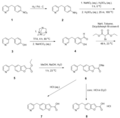Furegrelate
Furegrelate is a pharmacological agent that belongs to the class of drugs known as thromboxane inhibitors. It is primarily used in the prevention and treatment of thrombosis, a condition characterized by the formation of blood clots within the blood vessels.
Mechanism of Action[edit]
Furegrelate works by inhibiting the synthesis of thromboxane A2, a substance that plays a crucial role in platelet aggregation and vasoconstriction. By blocking the production of thromboxane A2, furegrelate prevents the clumping together of platelets, thereby reducing the risk of clot formation.
Clinical Uses[edit]
Furegrelate is used in the management of conditions that are associated with an increased risk of thrombosis, such as coronary artery disease, stroke, and peripheral artery disease. It may also be used in patients who have undergone angioplasty or stent placement to prevent clot formation and restenosis.
Side Effects[edit]
Like all drugs, furegrelate can cause side effects. These may include nausea, vomiting, diarrhea, and abdominal pain. In rare cases, it may cause bleeding or bruising. Patients should be monitored closely for these side effects during treatment.
Contraindications[edit]
Furegrelate is contraindicated in patients with a known allergy to the drug. It should also be used with caution in patients with a history of bleeding disorders or those who are taking other anticoagulants or antiplatelet drugs.
Drug Interactions[edit]
Furegrelate may interact with other drugs, including other anticoagulants, antiplatelet drugs, and certain antidepressants. These interactions can increase the risk of bleeding and should be avoided.
Dosage and Administration[edit]
The dosage of furegrelate is determined by the treating physician based on the patient's condition and response to treatment. It is usually taken orally, with or without food.
See Also[edit]
-
Furegrelate
-
Furegrelate synthetic pathway
-
Furegrelate precursor synthetic pathway
Ad. Transform your life with W8MD's Budget GLP-1 injections from $75


W8MD offers a medical weight loss program to lose weight in Philadelphia. Our physician-supervised medical weight loss provides:
- Weight loss injections in NYC (generic and brand names):
- Zepbound / Mounjaro, Wegovy / Ozempic, Saxenda
- Most insurances accepted or discounted self-pay rates. We will obtain insurance prior authorizations if needed.
- Generic GLP1 weight loss injections from $75 for the starting dose.
- Also offer prescription weight loss medications including Phentermine, Qsymia, Diethylpropion, Contrave etc.
NYC weight loss doctor appointmentsNYC weight loss doctor appointments
Start your NYC weight loss journey today at our NYC medical weight loss and Philadelphia medical weight loss clinics.
- Call 718-946-5500 to lose weight in NYC or for medical weight loss in Philadelphia 215-676-2334.
- Tags:NYC medical weight loss, Philadelphia lose weight Zepbound NYC, Budget GLP1 weight loss injections, Wegovy Philadelphia, Wegovy NYC, Philadelphia medical weight loss, Brookly weight loss and Wegovy NYC
|
WikiMD's Wellness Encyclopedia |
| Let Food Be Thy Medicine Medicine Thy Food - Hippocrates |
Medical Disclaimer: WikiMD is not a substitute for professional medical advice. The information on WikiMD is provided as an information resource only, may be incorrect, outdated or misleading, and is not to be used or relied on for any diagnostic or treatment purposes. Please consult your health care provider before making any healthcare decisions or for guidance about a specific medical condition. WikiMD expressly disclaims responsibility, and shall have no liability, for any damages, loss, injury, or liability whatsoever suffered as a result of your reliance on the information contained in this site. By visiting this site you agree to the foregoing terms and conditions, which may from time to time be changed or supplemented by WikiMD. If you do not agree to the foregoing terms and conditions, you should not enter or use this site. See full disclaimer.
Credits:Most images are courtesy of Wikimedia commons, and templates, categories Wikipedia, licensed under CC BY SA or similar.
Translate this page: - East Asian
中文,
日本,
한국어,
South Asian
हिन्दी,
தமிழ்,
తెలుగు,
Urdu,
ಕನ್ನಡ,
Southeast Asian
Indonesian,
Vietnamese,
Thai,
မြန်မာဘာသာ,
বাংলা
European
español,
Deutsch,
français,
Greek,
português do Brasil,
polski,
română,
русский,
Nederlands,
norsk,
svenska,
suomi,
Italian
Middle Eastern & African
عربى,
Turkish,
Persian,
Hebrew,
Afrikaans,
isiZulu,
Kiswahili,
Other
Bulgarian,
Hungarian,
Czech,
Swedish,
മലയാളം,
मराठी,
ਪੰਜਾਬੀ,
ગુજરાતી,
Portuguese,
Ukrainian


